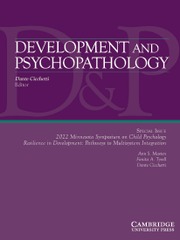Crossref Citations
This article has been cited by the following publications. This list is generated based on data provided by
Crossref.
Capusan, A. J.
Kuja-Halkola, R.
Bendtsen, P.
Viding, E.
McCrory, E.
Marteinsdottir, I.
and
Larsson, H.
2016.
Childhood maltreatment and attention deficit hyperactivity disorder symptoms in adults: a large twin study.
Psychological Medicine,
Vol. 46,
Issue. 12,
p.
2637.
Lansford, Jennifer E.
Bornstein, Marc H.
Deater‐Deckard, Kirby
Dodge, Kenneth A.
Al‐Hassan, Suha M.
Bacchini, Dario
Bombi, Anna Silvia
Chang, Lei
Chen, Bin‐Bin
Di Giunta, Laura
Malone, Patrick S.
Oburu, Paul
Pastorelli, Concetta
Skinner, Ann T.
Sorbring, Emma
Steinberg, Laurence
Tapanya, Sombat
Alampay, Liane P.
Uribe Tirado, Liliana M.
and
Zelli, Arnaldo
2016.
How International Research on Parenting Advances Understanding of Child Development.
Child Development Perspectives,
Vol. 10,
Issue. 3,
p.
202.
Rohner, Ronald P.
and
Lansford, Jennifer E.
2017.
Deep Structure of the Human Affectional System: Introduction to Interpersonal Acceptance–Rejection Theory.
Journal of Family Theory & Review,
Vol. 9,
Issue. 4,
p.
426.
Self-Brown, Shannon
Osborne, Melissa C.
Lai, Betty S.
De Veauuse Brown, Natasha
Glasheen, Theresa L.
and
Adams, Melissa C.
2017.
Initial Findings from a Feasibility Trial Examining the SafeCare Dad to Kids Program with Marginalized Fathers.
Journal of Family Violence,
Vol. 32,
Issue. 8,
p.
751.
Lansford, Jennifer E.
Al-Hassan, Suha M.
Bacchini, Dario
Bornstein, Marc H.
Chang, Lei
Chen, Bin-Bin
Deater-Deckard, Kirby
Di Giunta, Laura
Dodge, Kenneth A.
Malone, Patrick S.
Oburu, Paul
Skinner, Ann T.
Pastorelli, Concetta
Sorbring, Emma
Steinberg, Laurence
Icenogle, Grace
Tapanya, Sombat
Alampay, Liane Peña
Uribe Tirado, Liliana Maria
and
Zelli, Arnaldo
2017.
Well-Being of Youth and Emerging Adults across Cultures.
Vol. 12,
Issue. ,
p.
235.
Rostad, Whitney L.
Self-Brown, Shannon
Boyd, Clinton
Osborne, Melissa
and
Patterson, Alexandria
2017.
Exploration of factors predictive of at-risk fathers' participation in a pilot study of an augmented evidence-based parent training program: A mixed methods approach.
Children and Youth Services Review,
Vol. 79,
Issue. ,
p.
485.
Roche, Steven
2017.
Child Protection and Maltreatment in the Philippines: A Systematic Review of the Literature.
Asia & the Pacific Policy Studies,
Vol. 4,
Issue. 1,
p.
104.
Fréchette, Sabrina
and
Romano, Elisa
2017.
How do parents label their physical disciplinary practices? A focus on the definition of corporal punishment.
Child Abuse & Neglect,
Vol. 71,
Issue. ,
p.
92.
Sim, Amanda
Bowes, Lucy
and
Gardner, Frances
2018.
Modeling the effects of war exposure and daily stressors on maternal mental health, parenting, and child psychosocial adjustment: a cross-sectional study with Syrian refugees in Lebanon.
Global Mental Health,
Vol. 5,
Issue. ,
Deater‐Deckard, Kirby
Godwin, Jennifer
Lansford, Jennifer E.
Bacchini, Dario
Bombi, Anna Silvia
Bornstein, Marc H.
Chang, Lei
Di Giunta, Laura
Dodge, Kenneth A.
Malone, Patrick S.
Oburu, Paul
Pastorelli, Concetta
Skinner, Ann T.
Sorbring, Emma
Steinberg, Laurence
Tapanya, Sombat
Alampay, Liane Peña
Uribe Tirado, Liliana Maria
Zelli, Arnaldo
and
Al‐Hassan, Suha M.
2018.
Within‐ and between‐person and group variance in behavior and beliefs in cross‐cultural longitudinal data☆.
Journal of Adolescence,
Vol. 62,
Issue. 1,
p.
207.
Pinto, Liliana
Lein, Adriana
Mahoque, Raquel
Wright, David W.
Sasser, Scott M.
and
Staton, Catherine A.
2018.
A cross-sectional exploratory study of knowledge, attitudes, and practices of emergency health care providers in the assessment of child maltreatment in Maputo, Mozambique.
BMC Emergency Medicine,
Vol. 18,
Issue. 1,
Brush, Barbara L.
Gultekin, Laura E.
Dowdell, Elizabeth B.
Saint Arnault, Denise M.
and
Satterfield, Katherine
2018.
Understanding Trauma Normativeness, Normalization, and Help Seeking in Homeless Mothers.
Violence Against Women,
Vol. 24,
Issue. 13,
p.
1523.
Soares, Ana Luiza G.
Matijasevich, Alicia
Menezes, Ana M.B.
Assunção, Maria Cecília
Wehrmeister, Fernando C.
Howe, Laura D.
and
Gonçalves, Helen
2018.
Adverse Childhood Experiences (ACEs) and Adiposity in Adolescents: A Cross‐Cohort Comparison.
Obesity,
Vol. 26,
Issue. 1,
p.
150.
Bornstein, Marc H.
Putnick, Diane L.
and
Suwalsky, Joan T. D.
2018.
Parenting cognitions → parenting practices → child adjustment? The standard model.
Development and Psychopathology,
Vol. 30,
Issue. 2,
p.
399.
Van der Kooij, Inger W.
Chotoe-Sanchit, Rita K.
Moerman, Gerben
Lindauer, Ramón J. L.
Roopnarine, Jaipaul R.
and
Graafsma, Tobi L. G.
2018.
Perceptions of Adolescents and Caregivers of Corporal Punishment: A Qualitative Study Among Indo-Caribbean in Suriname.
Violence and Victims,
Vol. 33,
Issue. 4,
p.
686.
Goulet, Mélissa
Hélie, Sonia
and
Clément, Marie-Ève
2018.
Child and family needs profiles among cases substantiated by child protection services.
Child Abuse & Neglect,
Vol. 81,
Issue. ,
p.
366.
Nkuba, Mabula
Hermenau, Katharin
and
Hecker, Tobias
2018.
Violence and maltreatment in Tanzanian families—Findings from a nationally representative sample of secondary school students and their parents.
Child Abuse & Neglect,
Vol. 77,
Issue. ,
p.
110.
Cui, Joy
Mistur, Elisabeth J.
Wei, Christine
Lansford, Jennifer E.
Putnick, Diane L.
and
Bornstein, Marc H.
2018.
Multilevel factors affecting early socioemotional development in humans.
Behavioral Ecology and Sociobiology,
Vol. 72,
Issue. 10,
Lírio, Josinete Gonçalves dos Santos
Gomes, Nadirlene Pereira
Paixão, Gilvânia Patrícia do Nascimento
Pereira, Álvaro
Magalhães, Júlia Renata Fernandes
Cruz, Moniky Araújo da
and
Sousa, Anderson Reis de
2018.
Abuso intrafamiliar na infância de homens em processo criminal por violência conjugal.
Acta Paulista de Enfermagem,
Vol. 31,
Issue. 4,
p.
423.
Pittner, Katharina
van Ijzendoorn, Marinus H.
Alink, Lenneke R. A.
Buisman, Renate S. M.
Compier-de Block, Laura H. C. G. C.
van den Berg, Lisa J. M.
Elzinga, Bernet M.
Lindenberg, Jolanda
Tollenaar, Marieke S.
Diego, Vincent P.
and
Bakermans-Kranenburg, Marian J.
2019.
The genetic and environmental etiology of child maltreatment in a parent-based extended family design.
Development and Psychopathology,
Vol. 31,
Issue. 1,
p.
157.




